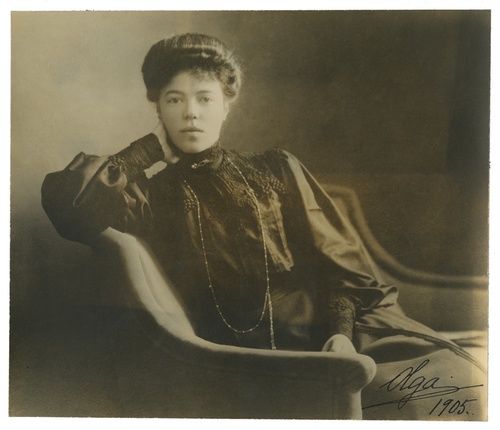
Auction: 352 - Autographs and Documents e-Auction
Lot: 139
[Russian Imperial Family]: Grand Duchess Olga Alexandrovna (1882-1960). Youngest child of Emperor Alexander III of Russia, youngest sister of Nicholas II. Photo Signed "Olga 1905". 8 ¾ x 7 ½ sepia photo of a thoughtful, young Grand Duchess Olga; she signs in black lower right. After her marriage to Duke Peter Alexandrovich of Oldenburg was annulled by her brother, the Tsar in 1916, Olga married Blue Cuirassier Guardsman Nikolai Kulikovsky with whom she had a long relationship. When the last surviving members of the Romanovs were evacuated by British warship in the aftermath of the Revolution, Olga and her husband refused to leave Russia. They moved to the Caucasus, which the White Army had cleared of Bolsheviks, and settled in a large Cossack village. In November 1919, they were forced to flee ahead of revolutionary troops, and escaped to Novorossiysk where they took refuge in the residence of the Danish consul, who informed them that the Dowager Empress had arrived safely in Denmark.
The couple were shipped to a refugee camp in the Dardanelles near Istanbul, then on to Belgrade. Prince Regent Alexander offered them a permanent home, but Olga was summoned to Denmark by her mother. Olga and her family settled into the royal estate of Hvidøre, where she acted as her mother's secretary and companion. After the Dowager Empress died in 1928, Olga purchased Knudsminde a farm in Ballerup near Copenhagen with her portion of the proceeds from the sale of her mother's estate. There, Olga and her husband Col. Kulikovsky kept horses and farm animals, raised their two sons; and Olga lived a life of simplicity. The farm, meanwhile, became the center of Denmark's Russian émigré community.
When Nazi Germany occupied neutral Denmark in 1940, Olga's two sons, both officers in the Danish army, were interned as POWs. But some Russian émigrés, keen to fight the Soviets, enlisted in the German forces. Olga herself was implicated in her compatriots' collusion as she continued to meet and aid émigrés in their fight against communism. After Soviet troops occupied the Danish island of Bornholm at the end of World War II, the Soviet Union wrote to the Danish government accusing Olga and a Danish Catholic bishop of conspiracy against the Soviet government. Fearing assassination or kidnapping, Olga moved her family across the Atlantic in 1948 to rural Canada as agricultural immigrants.
They purchased a 200-acre farm in Ontario near Campbellville. But by 1952, the farm had become a burden to the now-elderly couple - their sons had moved away, Colonel Kulikovsky suffered ill-health and some of Olga's remaining jewelry had been stolen. They sold the farm and moved to a smaller, five-room house in Cooksville. Visitors to the area and foreign and royal dignitaries took interest in Olga and visited her in Cooksville. By 1958, Colonel Kulikovsky was largely paralyzed, and Olga sold her remaining jewelry to raise funds. Following his death that year, she became increasingly infirm. Unable to care for herself, she stayed with émigré friends in an apartment above a beauty salon in Toronto. Grand Duchess Olga Alexandrovna died November 24, 1960. She was interred next to her husband in York Cemetery, Toronto after a funeral service at Christ the Saviour Cathedral where officers of the Akhtyrsky Hussars and the Blue Cuirassiers stood guard.
Estimate
Starting price
$100




